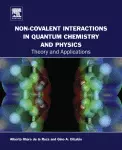Table Of ContentNON-COVALENT INTERACTIONS
IN QUANTUM CHEMISTRY AND PHYSICS:
THEORY AND APPLICATIONS
NON-COVALENT
INTERACTIONS
IN QUANTUM
CHEMISTRY
AND PHYSICS:
THEORY AND
APPLICATIONS
Editedby
Alberto Otero de la Roza
Gino A. DiLabio
Elsevier
Radarweg29,POBox211,1000AEAmsterdam,Netherlands
TheBoulevard,LangfordLane,Kidlington,OxfordOX51GB,UnitedKingdom
50HampshireStreet,5thFloor,Cambridge,MA02139,UnitedStates
Copyright©2017ElsevierInc.Allrightsreserved.
Nopartofthispublicationmaybereproducedortransmittedinanyformorbyanymeans,electronicormechanical,
includingphotocopying,recording,oranyinformationstorageandretrievalsystem,withoutpermissioninwritingfrom
thepublisher.Detailsonhowtoseekpermission,furtherinformationaboutthePublisher’spermissionspoliciesandour
arrangementswithorganizationssuchastheCopyrightClearanceCenterandtheCopyrightLicensingAgency,canbe
foundatourwebsite:www.elsevier.com/permissions.
ThisbookandtheindividualcontributionscontainedinitareprotectedundercopyrightbythePublisher(otherthanas
maybenotedherein).
Notices
Knowledgeandbestpracticeinthisfieldareconstantlychanging.Asnewresearchandexperiencebroadenour
understanding,changesinresearchmethods,professionalpractices,ormedicaltreatmentmaybecomenecessary.
Practitionersandresearchersmustalwaysrelyontheirownexperienceandknowledgeinevaluatingandusingany
information,methods,compounds,orexperimentsdescribedherein.Inusingsuchinformationormethodstheyshouldbe
mindfuloftheirownsafetyandthesafetyofothers,includingpartiesforwhomtheyhaveaprofessionalresponsibility.
Tothefullestextentofthelaw,neitherthePublishernortheauthors,contributors,oreditors,assumeanyliabilityforany
injuryand/ordamagetopersonsorpropertyasamatterofproductsliability,negligenceorotherwise,orfromanyuseor
operationofanymethods,products,instructions,orideascontainedinthematerialherein.
LibraryofCongressCataloging-in-PublicationData
AcatalogrecordforthisbookisavailablefromtheLibraryofCongress
BritishLibraryCataloguing-in-PublicationData
AcataloguerecordforthisbookisavailablefromtheBritishLibrary
ISBN:978-0-12-809835-6
ForinformationonallElsevierpublicationsvisitourwebsiteat
https://www.elsevier.com/books-and-journals
Publisher:JohnFedor
AcquisitionEditor:JohnFedor
EditorialProjectManager:SarahWatson
ProductionProjectManager:MariaBernard
Designer:VictoriaPearson
TypesetbyVTeX
Toourcolleagues
Contributors
Gregory J.O. Beran Department of Chemistry, PerHyldgaard MicrotechnologyandNanoscience,
UniversityofCaliforniaRiverside,Riverside,CA, MC2, Chalmers University of Technology, Göte-
USA borg,Sweden
Kristian Berland CentreforMaterialsScienceand Erin R. Johnson Department of Chemistry, Dal-
Nanotechnology, SMN, University of Oslo, Oslo, housieUniversity,Halifax,NS,Canada
Norway Christopher N. Lam CenterforNanophaseMate-
Jan Gerit Brandenburg Department of Chemistry, rialsScience,OakRidgeNationalLaboratory,Oak
UniversityCollegeLondon,London,UK Ridge,TN,USA
Jean-LucBrédas LaboratoryforComputationaland Musen Li International Centre for Quantum and
TheoreticalChemistryofAdvancedMaterials,Di- Molecular Structure, College of Sciences, Shang-
vision of Physical Science and Engineering, King haiUniversity,Shanghai,China
Abdullah University of Science and Technology, Bengt I. Lundqvist Department of Physics,
Thuwal,SaudiArabia Chalmers University of Technology, Göteborg,
Valentino R. Cooper MaterialsScienceandTech- Sweden
nology Division, Oak Ridge National Laboratory, A.MartínPendás DepartamentodeQuímicaFísica
OakRidge,TN,USA yAnalítica, Facultad deQuímica, Universidad de
Gino A. DiLabio Department of Chemistry, The Oviedo,Oviedo,Spain
University of British Columbia, Kelowna, BC, Benedetta Mennucci Department of Chemistry,
Canada UniversityofPisa,Pisa,Italy
MichaelJ.Ford SchoolofMathematicalandPhys- Sarah L. Price Department of Chemistry, Univer-
ical Sciences, University of Technology Sydney,
sityCollegeLondon,London,UK
Sydney,Australia
Mahesh Kumar Ravva Laboratory for Computa-
E. Francisco Departamento de Química Física y
tional and Theoretical Chemistry of Advanced
Analítica, Facultad de Química, Universidad de
Materials, Division of Physical Science and Engi-
Oviedo,Oviedo,Spain
neering,KingAbdullahUniversityofScienceand
LarsGoerigk SchoolofChemistry,TheUniversity Technology,Thuwal,SaudiArabia
ofMelbourne,Melbourne,Australia
JeffreyR.Reimers InternationalCentreforQuan-
Tim Gould Queensland Micro- and Nanotechnol- tumandMolecularStructure,CollegeofSciences,
ogyCentre,GriffithUniversity,Nathan,Australia ShanghaiUniversity,Shanghai,China;
Joshua D. Hartman Department of Chemistry, School of Mathematical and Physical Sciences,
UniversityofCaliforniaRiverside,Riverside,CA, University of Technology Sydney, Sydney, Aus-
USA tralia
Yonaton N. Heit Department of Chemistry, Uni- Chad Risko DepartmentofChemistryandCenter
versity of California Riverside, Riverside, CA, for Applied Energy Research, University of Ken-
USA tucky,Lexington,KY,USA
Andreas Heßelmann Lehrstuhl für Theoretische Elsebeth Schröder Microtechnology and Nano-
Chemie, Universität Erlangen-Nürnberg, Erlan- science,MC2,ChalmersUniversityofTechnology,
gen,Germany Göteborg,Sweden
xiii
xiv
CONTRIBUTORS
C.DavidSherrill CenterforComputationalMolec- Timo Thonhauser Department of Physics, Wake
ular Science and Technology, School of Chem- ForestUniversity,Winston-Salem,NC,USA;
istry and Biochemistry, and School of Computa- DepartmentofChemistry,MassachusettsInstitute
tional Science and Engineering, Georgia Institute ofTechnology,Cambridge,MA,USA
ofTechnology,Atlanta,GA,USA Dongya Wan International Centre for Quantum
AnthonyJ.Stone UniversityChemicalLaboratory, and Molecular Structure, College of Sciences,
UniversityofCambridge,Cambridge,UK ShanghaiUniversity,Shanghai,China
Bobby G. Sumpter CenterforNanophaseMateri- Yangyang Wang Center for Nanophase Materi-
als Science, Oak Ridge National Laboratory, Oak als Science, Oak Ridge National Laboratory, Oak
Ridge,TN,USA Ridge,TN,USA
Foreword
In 2004, I attended a seminar by Mark is a beautifully seamless density-functional
Ratner in which he delivered this memo- methodwithelectrongastheoryatitsheart.
rable introduction: “Chemistry of the 20th In 2005, the first nonempirical DFT method
century was about intramolecular interac- for computing pairwise interatomic disper-
tions; chemistry of the 21st century will sion coefficients for atoms in molecules
be about intermolecular interactions.” The
(“XDM”) was introduced. XDM uses the
present volume is an inspiring look at the
position-dependent dipole moment of each
promise of computational chemistry in the
electron and its exchange hole to generate
21st century. It deals with molecular crys-
the dispersion interactions. Other nonem-
tals, surfaces, biological complexes, etc., all
pirical DFT approaches with the power to
dominated by noncovalent van der Waals
sense chemical environments rapidly fol-
(vdW) or dispersion interactions, the weak-
lowed.
est and computationally most challenging
These developments were dramatic and
interactions in nature. Each of the various
timely. Density-functional theory was our
chapters is a comprehensive review of its
subject area. There are chapters on funda- prime hope for computations on very large
mental physical principles, computational systems in chemistry, biology, materials and
approaches rooted both in wavefunction surfacescience.Sincethemid1980s,progress
theory (WFT) and density-functional the- in density functionals for intramolecular
ory (DFT), visualization tools, and applica- bonding and molecular structure had revo-
tions. lutionized quantum chemistry. Without the
The applications range from crystal poly- inherent ability to describe noncovalent in-
morph prediction, to the structures of or- teractions, however, DFT was doomed. The
ganic electronic materials, to adsorption of decadefrom2000to2010markedawelcome
molecules on metal surfaces. The scale of
DFTresurgence.
these applications was unimaginable for
TheinterplaybetweenWFTandDFTwas,
computational scientists even 10 or 15 years
at the time, critical, and continues to be. It
ago. Circa 2000, model force fields were the
isWFTthatprovidesthenecessaryreference
only viable approach to large-scale compu-
data on which to assess developments in
tations involving noncovalent interactions.
DFT.Theearly“S22”and“S66”intermolecu-
The deficiencies were severe. How should
larWFTdatasetswereinvaluable.Thenum-
the numerous required parameters be ob-
ber and diversity of reference data sets con-
tained? Even after obtaining them, how can
changesinthechemicalenvironmentofeach tinues to grow, and now includes molecu-
atombeconveyed? lar crystal data extracted from experimental
The first nonempirical DFT-based strat- sublimationenthalpies.
egy for computing intermolecular interac- Thechaptersinthisvolumeaddressallof
tions appeared circa 2004 (“vdW-DF”). This theaboveandmore.Ithasbeenanexhilarat-
xv
xvi
FOREWORD
ing15years(orso)asthecomputationalsci- itselftothe21st-centuryfuture.Youwillfind
enceofnoncovalentinteractionshasadapted anexcellentoverviewhere.
AxelD.Becke
DalhousieUniversity,Halifax,Canada
October2016
C H A P T E R
1
Physical Basis of Intermolecular
Interactions
Anthony J. Stone
UniversityChemicalLaboratory,UniversityofCambridge,Cambridge,UK
1.1 INTRODUCTION
Noncovalent interactions occur everywhere: in interactions between molecules in gases,
liquidsandsolidmaterialsofallkinds,butalsobetweenpartsoflargemoleculessuchaspro-
teins.Understandingandpredictingthebehaviorofsuchsystemscallsforadetailedphysical
understandingofthenatureoftheseinteractions,andtheirbehaviorasfunctionsofthesep-
arationandrelativeorientationofthemolecules.
While methods are available to calculate interaction energies between molecules to high
accuracy, such methods are usually impracticable for applications such as simulations of
large molecules or large numbers of small molecules. In many applications there is a con-
flictbetweenaccuracyandcomputationalefficiency,soitisimportanttofindanappropriate
compromise.Insuchcasesaccuratecalculationsareneededasabasisforderivingsimplified
models. It was usual in the past to fit model parameters to empirical data, but it is difficult
to obtain enough satisfactory data in this way, and it is generally better to derive the mod-
elsfromabinitiocalculationsandtotestthem,andperhapsrefinethem,byreferencetothe
empiricaldata.Anunderstandingofthetheoreticalbasisfortheinteractionisalsohelpfulin
findingthebestformforthemodelpotentialfunction.
Thischapterprovidesanoverviewofthegeneralideasunderlyingthecalculationofinter-
molecular interactions. For more details the reader is referred to Ref. [1]. We deal here only
withthemostcommoncase,ofclosed-shellmoleculesinnondegenerategroundstates,and
we develop the concepts from a perturbation-theory viewpoint. An alternative approach is
energydecompositionanalysis,whichwillbetreatedinChapter2.
1.1.1 Pairwise Additivity
Whendealingwithanassemblyofseveralmolecules,itisusuallyimpracticaltotreatthe
systemasawhole.Insteadweusuallystartbyassumingpairwiseadditivity:thatis,thetotal
Non-covalentInteractionsinQuantumChemistryandPhysics 3
DOI:10.1016/B978-0-12-809835-6.00002-5 Copyright©2017ElsevierInc.Allrightsreserved.

